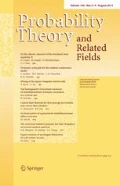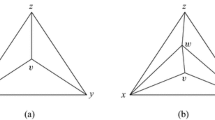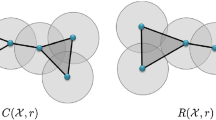Abstract
We consider the topology of simplicial complexes with vertices the points of a random point process and faces determined by distance relationships between the vertices. In particular, we study the Betti numbers of these complexes as the number of vertices becomes large, obtaining limit theorems for means, strong laws, concentration inequalities and central limit theorems. As opposed to most prior papers treating random complexes, the limit with which we work is in the so-called ‘thermodynamic’ regime (which includes the percolation threshold) in which the complexes become very large and complicated, with complex homology characterised by diverging Betti numbers. The proofs combine probabilistic arguments from the theory of stabilizing functionals of point processes and topological arguments exploiting the properties of Mayer–Vietoris exact sequences. The Mayer–Vietoris arguments are crucial, since homology in general, and Betti numbers in particular, are global rather than local phenomena, and most standard probabilistic arguments are based on the additivity of functionals arising as a consequence of locality.
Similar content being viewed by others
Notes
The \(\tilde{H}_k\) are the reduced homology groups and it suffices to note that \(\tilde{H}_k \cong H_k\) for \(k \ne 0\) and \(H_0 \cong \tilde{H}_0 \oplus {\mathbb {F}}\).
References
Akcoglu, M.A., Krengel, U.: Ergodic theorems for superadditive processes. J. Reine Angew. Math. 323, 53–67 (1981)
Björner, A.: Topological methods. In: Graham, R., Grötschel, M., Lovász, L. (eds.) Handbook of Combinatorics, vol. 2, pp. 1819–1872. Elsevier, Amsterdam (1995)
Bobrowski, O., Adler, R.J.: Distance functions, critical points, and the topology of random Čech complexes. Homol. Homotopy Appl. 16(2), 311–344 (2014)
Bobrowski, O., Kahle, M.: Topology of random geometric complexes: a survey (2014). arXiv:1409.4734
Bobrowski, O., Mukherjee, S.: The topology of probability distributions on manifolds. Probab. Theory Relat. Fields 161(3–4), 651–686 (2015)
Carlsson, G.: Topology and data. Bull. Am. Math. Soc. (N.S.) 46(2), 255–308 (2009)
Carlsson, G.: Topological pattern recognition for point cloud data. Acta Numer. 23, 289–368 (2014)
Chalker, T.K., Godbole, A.P., Hitczenko, P., Radcliff, J., Ruehr, O.G.: On the size of a random sphere of influence graph. Adv. Appl. Probab. 31(3), 596–609 (1999)
Costa, A.E., Farber, M., Kappeler, T.: Topics of stochastic algebraic topology. In: Proceedings of the Workshop on Geometric and Topological Methods in Computer Science (GETCO). Electronic Notes in Theoretical Computer Science, vol. 283(0), pp. 53–70 (2012)
Decreusefond, L., Ferraz, E., Randriam, H., Vergne, A.: Simplicial homology of random configurations. Adv. Appl. Probab. 46, 1–20 (2014)
Delfinado, C.J.A., Edelsbrunner, H.: An incremental algorithm for Betti numbers of simplicial complexes. In: Proceedings of the Ninth Annual Symposium on Computational Geometry, SCG ’93, New York, NY, USA, pp. 232–239. ACM (1993)
Edelsbrunner, H., Harer, J.L.: Computational Topology, An Introduction. American Mathematical Society, Providence (2010)
Efron, B., Stein, C.: The jackknife estimate of variance. Ann. Stat. 9(3), 586–596 (1981)
Forman, R.: A user’s guide to discrete Morse theory. Sém. Lothar. Comb. 48, (2002)
Ghrist, R.: Barcodes: the persistent topology of data. Bull. Am. Math. Soc. (N.S.) 45(1), 61–75 (2008)
Hall, P.: Introduction to the theory of coverage processes. In: Wiley Series in Probability and Mathematical Statistics: Probability and Mathematical Statistics. Wiley, New York (1988)
Hatcher, A.: Algebraic Topology. Cambridge University Press, Cambridge (2002)
Hug, D., Last, G., Schulte, M.: Second order properties and central limit theorems for geometric functionals of Boolean models. Ann. Appl. Probab. (2013) (to appear). arXiv:1308.6519
Kahle, M.: Random geometric complexes. Discret. Comput. Geom. 45(3), 553–573 (2011)
Kahle, M.: Topology of random simplicial complexes: a survey. In: Tillmann, U., Galatius, S., Sinha, D. (eds.) Algebraic Topology: Applications and New Directions. Contemporary Mathematics, vol. 620, pp. 201–221. American Mathematical Society, Providence (2014)
Kahle, M., Meckes, E.: Limit theorems for Betti numbers of random simplicial complexes. Homol. Homotopy Appl. 15(1), 343–374 (2013)
Last, G., Penrose, M.D.: Poisson process Fock space representation, chaos expansion and covariance inequalities. Probab. Theory Relat. Fields 150(3–4), 663–690 (2011)
Last, G., Peccatti, G., Schulte, M.: Normal approximation on Poisson spaces: Mehler’s formula, second order Poincaré inequality and stabilization. Probab. Theory Relat. Fields 1–57 (2015). doi:10.1007/s00440-015-0643-7
Linial, N., Meshulam, R.: Homological connectivity of random 2-complexes. Combinatorica 26(4), 475–487 (2006)
Meester, R., Roy, R.: Continuum Percolation. Cambridge University Press, Cambridge (1996)
Munkres, J.R.: Elements of Algebraic Topology. Addison-Wesley, Reading (1984)
Niyogi, P., Smale, S., Weinberger, S.: Finding the homology of submanifolds with high confidence from random samples. Discret. Comput. Geom. 39(1–3), 419–441 (2008)
Niyogi, P., Smale, S., Weinberger, S.: A topological view of unsupervised learning from noisy data. SIAM J. Comput. 40(3), 646–663 (2011)
Nourdin, I., Peccati, G.: Normal approximations with Malliavin calculus. In: Cambridge Tracts in Mathematics, vol. 192. Cambridge University Press, Cambridge (2012). From Stein’s method to universality
Pemantle, R., Peres, Y.: Concentration of Lipschitz functionals of determinantal and other strong Rayleigh measures. Combin. Probab. Comput. 23, 140–160 (2013)
Penrose, M.D.: Random Geometric Graphs. Oxford University Press, New York (2003)
Penrose, M.D.: Laws of large numbers in stochastic geometry with statistical applications. Bernoulli 13(4), 1124–1150 (2007)
Penrose, M.D., Yukich, J.E.: Central limit theorems for some graphs in computational geometry. Ann. Appl. Probab. 11(4), 1005–1041 (2001)
Sarkar, A.: Co-existence of the occupied and vacant phase in Boolean models in three or more dimensions. Adv. Appl. Probab. 29(4), 878–889 (1997)
Schneider, R., Weil, W.: Stochastic and integral geometry. In: Probability and its Applications (New York). Springer, Berlin (2008)
Schulte, M.: Malliavin–Stein method in stochastic geometry. Ph.D. thesis (2013). http://repositorium.uni-osnabrueck.de/handle/urn:nbn:de:gbv:700-2013031910717
Spanier, E.H.: Algebraic Topology. McGraw-Hill Book Co., New York (1966)
Steele, J.M.: An Efron-Stein inequality for nonsymmetric statistics. Ann. Stat. 14(2), 753–758 (1986)
Steele, J.M.: Probability theory and combinatorial optimization. In: CBMS-NSF Regional Conference Series in Applied Mathematics, vol. 69. SIAM, Philadelphia (1997)
Stoyan, D., Kendall, W., Mecke, J.: Stochastic Geometry and its Applications. Wiley, Chichester (1995)
Tanemura, H.: Critical behavior for a continuum percolation model. In: Probability Theory and Mathematical Statistics (Tokyo, 1995), pp. 485–495. World Scientific Publishing, River Edge (1996)
Yogeshwaran, D., Adler, R.J.: On the topology of random complexes built over stationary point processes. Ann. Appl. Probab. 25(6), 3338–3380 (2015)
Yukich, J.E.: Probability theory of classical Euclidean optimization problems. Lecture Notes in Mathematics, vol. 1675. Springer, Berlin, Heidelberg (1998)
Zomorodian, A.: Topological data analysis. In: Advances in Applied and Computational Topology. Proceedings of Symposia in Applied Mathematics, vol. 70, pp. 1–39. American Mathematical Society, Providence (2012)
Zomorodian, A.J.: Topology for computing. Cambridge Monographs on Applied and Computational Mathematics, vol. 16. Cambridge University Press, Cambridge (2009)
Acknowledgments
The work has benefitted from discussions with various people. On the topology side, we are thankful to Antonio Rieser and Primoz Skraba. On the probability side, Joseph Yukich answered many questions about the literature on sub-additive and stabilizing functionals, while Mathias Schulte explained to DY the variance lower bound technique of Lemma 5.1. Thanks are also due to his co-authors Günter Last and Giovanni Peccatti for sharing their results with us in advance of publication.
Author information
Authors and Affiliations
Corresponding author
Additional information
D. Yogeshwaran’s research was supported in part by FP7-ICT-318493-STREP.
Eliran Subag’s research was supported in part by Israel Science Foundation, 853/10.
Robert J. Adler’s research was supported in part by AFOSR FA8655-11-1-3039 and ERC 2012 Advanced Grant 20120216.
Appendices
Appendices
1.1 Appendix 1
The following useful lemma needed for variance lower bounds is essentially a simplification of [23, Theorem 5.2] to our situation.
Lemma 5.1
Let \(n \ge 1\) and \({\mathcal {P}}_n\) be the Poisson point process with density nf, where f satisfies (4.1). Let F be a translation invariant functional on locally finite point sets of \({\mathbb {R}}^d\) such that \({\mathbb {E}}\left\{ F({\mathcal {P}}_n)^2\right\} < \infty \). Assume that there exist \(m \in {\mathbb {N}},\) a set \(A \subset \mathrm{{supp}}(f),\) a finite set of points \(z_1,\ldots , z_{m}\) and \(r > 0\) with \(A \oplus B_{z_i}(r) \subset \mathrm{{supp}}(f)\) for all \(i \in \{1,\ldots ,m\}\) such that for all \(x \in A \) and \((x_1,\ldots ,x_m) \in \prod _{i=1}^mB_{x+z_i}(r),\) we have that
for some positive constant c. Then
Proof
[23, Theorem 5.3] simplifies [23, Theorem 5.2] to the case of stationary Poisson point processes in Euclidean space. However, since we are dealing with Poisson point processes with non-uniform densities, we require a small change in the arguments there and shall describe this in a moment. In any case, the similarity of our lower bound (5.2) to that of [23, Theorem 5.3] is to be expected. In particular, if we set \(f_* = f^* = \lambda \), then (5.2) is exactly the variance lower bound in [23, Theorem 5.3] with t there replaced by \(\lambda n\) here (although the set A and r are different).
Now, more specifically, set
Note that this plays the role of U as defined in [23, Theorem 5.2] and defining g on U as
we have that \(g > c/2\) Lebesgue a.e. on U. Setting \(\nu _n(.)\) to be the intensity measure of the point process \({\mathcal {P}}_n\), we have that
where we recall that |.| stands for the Lebesgue measure on \({\mathbb {R}}^d\). Using these bounds for \(\nu _n(.)\), we firstly obtain that
Secondly, let \(\emptyset \ne J \subset \{1,\ldots ,m+1\}\) and for \(y = (y_1,\ldots ,y_{m+1}) \in {\mathbb {R}}^{d(m+1)}\), let \(y_J\) be the components of y with indices in J. If \(y \in U\), then \(|y_i - y_j| \le 2r\) for all \(1 \le i,j \le m+1\) and so for any \(y_J \in {\mathbb {R}}^{d|J|}\), we have that
Using the above upper and lower bounds in the proof of [23, Theorem 5.3] along with the a.e. lower bound for g on U, (5.2) follows. \(\square \)
1.2 Appendix 2
We use the notation of Sect. 4.2, and consider a sequence \(\{B_n\}\) of subsets of \({\mathbb {R}}^d\) satisfying Conditions (A)–(D) there.
Given such a sequence, let \({\mathfrak {B}}\) (\(={\mathfrak {B}}(\{B_n\})\)) be the collection of all subsets A of \({\mathbb {R}}^d\) such that \(A = B_n + x\) for some \(B_n\) in the sequence and some point \(x \in {\mathbb {R}}^d\).
For a \(A \in {\mathfrak {B}}\), we shall denote by \({{\mathcal {U}}}_{m,A}\) the point process obtained by choosing m points uniformly in A. Then the extended binomial process \({{\mathcal {U}}}_n\) of Sect. 4.2 is equivalent to \({{\mathcal {U}}}_{n,B_n}\) in the current notation.
Theorem 5.2
[33, Theorem 2.1] Let H be a real-valued functional defined for all finite subsets of \({\mathbb {R}}^d\) and satisfying the following four conditions :
-
1.
Translation invariance: \(H({{\mathcal {X}}}+ y) = H({{\mathcal {X}}})\) for all finite subsets \({{\mathcal {X}}}\) and \(y \in {\mathbb {R}}^d\).
-
2.
Strong stabilization: H is called strongly stabilizing if there exist a.s. finite random variables R (called the radius of stabilization for H) and \(D_H(\infty )\) such that, with probability 1,
$$\begin{aligned} (D_OH)\big (({\mathcal {P}}\cap B_O(R)) \cup A\big )= D_H(\infty ) \end{aligned}$$for all finite \(A \subset B_O(R)^c\).
-
3.
Uniformly bounded moments:
$$\begin{aligned} \sup _{A \in {\mathfrak {B}} ; \, 0 \in A} \, \sup _{m \in \left[ {|A|}/{2},{3|A|}/{2}\right] }{\mathbb {E}}\left\{ \left[ (D_OH)({{\mathcal {U}}}_{m,A})\right] ^4\right\} <\infty . \end{aligned}$$ -
4.
Polynomial boundedness: There is a constant \(b_2\) such that, for all finite subsets \({{\mathcal {X}}}\subset {\mathbb {R}}^d,\)
$$\begin{aligned} |H({{\mathcal {X}}})| \le b_2\left[ \mathrm{diam}({{\mathcal {X}}}) +| {{\mathcal {X}}}|\right] ^{b_2}. \end{aligned}$$(5.3)
Then, there exist constants \(\sigma ^2,\tau ^2\) with \(0 \le \tau ^2 \le \sigma ^2,\) such that, as \(n \rightarrow \infty ,\)
and
where \(\Rightarrow \) denotes convergence in distribution. The constants \(\sigma ^2,\tau ^2\) are independent of the choice of \(B_n\). If \(D_H(\infty )\) is non-degenerate, then \(\tau ^2 > 0\) and also \(\sigma ^2 > 0\). Further, if \({\mathbb {E}}\left\{ D_H(\infty )\right\} \ne 0,\) then \(\tau ^2 < \sigma ^2\).
The last statement follows from the remark below [33, Theorem 2.1]. In the Poisson case the strongly stabilizing condition required for the central limit theorem can be replaced by the so-called weak stabilization condition, as in [33, Theorem 3.1]. H is said to be weakly stabilizing if there exists a random variable \(D_{\infty }(H)\) such that
for any \({\mathfrak {B}}\)-valued sequence \(A_n\) growing to \({\mathbb {R}}^d\).
Rights and permissions
About this article
Cite this article
Yogeshwaran, D., Subag, E. & Adler, R.J. Random geometric complexes in the thermodynamic regime. Probab. Theory Relat. Fields 167, 107–142 (2017). https://doi.org/10.1007/s00440-015-0678-9
Received:
Revised:
Published:
Issue Date:
DOI: https://doi.org/10.1007/s00440-015-0678-9




